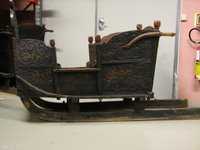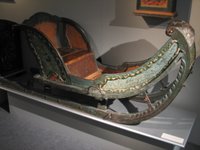Friday, June 30, 2006
Lillehammer, June 25-27








 Lillehammer was fantastic (no time for posting updates though). On the train to Lillehammer, the person sitting next to me was a deaf girl in high school or maybe college. It was wonderful practice for me to talk to her because I got to write in Norwegian, and she would write back in English. This is much easier than actually speaking and listening. She hates George Bush, by the way.
Lillehammer was fantastic (no time for posting updates though). On the train to Lillehammer, the person sitting next to me was a deaf girl in high school or maybe college. It was wonderful practice for me to talk to her because I got to write in Norwegian, and she would write back in English. This is much easier than actually speaking and listening. She hates George Bush, by the way.At Lillehammer, I was welcomed into Maihaugan, a museum complex consisting of a large open air museum of dozens of old buildings collected from this region of Norway and set into a village, as well as an actual musem with a large collection of Norwegian objects. The curator, Kåre Hosar, left me the keys to the museum's guest house, so I had my own apartment for a few days.
The collection is huge, but most of it is behind locked doors. Lucky for me, Kåre Hosar was able to spend the better part of the day with me, escorting me through the storage, allowing me to pull out all of the objects I wanted to see and photograph. He also is an expert on the collection, and quickly educated me on many aspects of Norwegian material culture. I was most interested in seeing the sleds, and then in any other wood objects particular to Norway. I got what I came for. There are dozens of sleds in storage there.
The sleds here are Norwegian. They are not Sami or Viking like the other sleds I saw in Oslo. The earilest sleds at this museum are from the 1600's. These are really box-like in form, and are not so different in construction from a Norwegian blanket chest with either tennons or nails at the corners. These are considered Renaissance sleds. The carving on them begins to show stylized botanical motifs with a very simple acanthus leaf. The acanthus leaf is Mediterranian, the one used to decorate the tops of Corinthian columns in ancient Greece. The acanthus motif continued to be an influence from ancient times through the Middle Ages, and through the Renaissance. The motif experienced a Baroque revival in Norwegian folk art in the 1700's, as one can see in these sleds. The acanthus leaf motif really flourished in Norwegian folk art after it appeared in the alter at the main church in Oslo in 1699, and then in the pulpit at Lillehammer in 1705. At this point, the sleds had very little metal in them, indicating that metal parts were still relatively unavailible and expensive.
In the mid to late 1700's, the decoration of the sleds blends several influences. The style of the carving- the twisting, elaborate botanical imagery in geometric layouts- is similar to the French Rococo style, but whereas the French would have shells and rocks as the imagery, the Norwegians were incorporating the classical acanthus leaf. The influence of the French becomes very apparent in the form of the sleds as they change to bulbous, curvilinear forms by the 1800's. This is the Empire style of the early 1800's. The panels of the sled sides are carved from thick, solid wood panels reminiscent of the "bombe" chests and cabinets from this era of French furnituremaking.
There were some other very interesting wood objects to see here, including a huge number of hand tools, especially planes. I am sure the College of the Redwoods crowd would have been thrilled to see these tools. Check out the enormous jointer plane I am holding!There were also numerous flat objects with handles that were intricately carved and painted. These are called "mangletre", and are used in conjunction with a rolling pin type rod for flattening clothes, some labor intensive way of ironing without heat. These objects are collectable because of how common they were to Norwegian households, and also because they were so decorative. Men would make these mangletre to prove their craft skills and to impress the women. A mangletre was the traditional engagement gift. I don't think a marraige proposal accompanied by the gift of an iron would go over so well anymore. . . a lot of guys would get big bumps on their heads for that one!Another odd object was a stick like a ruler with notches and pictographs down the edges. These are called "primstav" and are a type of almanac with every day of the year as a tic or notch, and then specific symbols to correspond with particular important days of the year. All primstav had the same symbols and days marked, so the marks were for important days on the Norwegian calendar, not personally important days like your Mom's birthday. If I make one, I will put everyone's bithday on it.